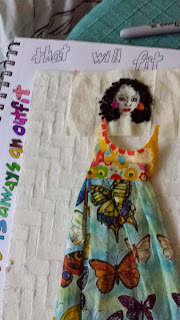Yes I have had trouble with my now almost defunct laptop, yes the light hasn't been brilliant to take satisfactory pictures, yes I have been busy trying to make things, learning new techniques and as usual riddled with doubts about the usefulness of all this. Of course other billions excuses come to my mind.
In January, while I was going through coping with a bit of a setback that I had encountered, I came across a "reader challenge" in the Cloth Paper and Scissor Magazine, www.clothpaperscissors.com. (Check out the link as there are lots of interesting free e-books and tips)
It was appealing even though the deadline seemed to be too close for my liking. Yet I thought I could give it a try and at the very least use it as an inspiration to do some work. After the deadline was passed and I (obviously) hadn't finished the piece, an email come through to announce that the deadline for that particular challenge had been extended, which caused me to frantically resume the work trying to meet the new one. In a very typical "Maria's scenario" I ended up sending some digital file at midnight of the due date from I don't really know which device, source, provider and the like. Did not get an acknowledgement receipt and still don't know if they actually received my entry. The piece though,came out quite nicely, I think. Probably not exactly what i wanted it to be. But it had given me permission for playing: with words, with paper, with colours and with ideas.
Lots of things with no practical outcome, things I perceive as a luxury that I can hardly afford right now. It cheers me up though, especially these days when spring plays hide and seek and one day promises what the next day cannot deliver.
It was about wearable art, which is one topic I really care about and also afforded me the chance to make some doll-like construction, which I had been fancying for a while
So I decided to make it about fitting, both in a sartorial sort of way and in a broader, more social one or even personal, if you like.
The planning process started within a sketchbook:
While the work could be tridimensional had to be fairly small :8"-10"(22-27cm) max, be able to fit in a flat-rate box or envelope and weigh less than a pound
Therefore "padded" flat (bas- relief?) seemed to me to be the best choice.
It had to contain some stitching but also some paper among the materials used including the base, so it seemed like a wonderful occasion to use up all those lovely bits of paper collected (ahem...) over the years and/or left over from other projects.
Hand embroidery for the face looked like a must
Then the actual outfit, made up of tissue paper from colorful napkins that I hadn't been able to part with, was added to a background of handmade lokta paper
there was also a little play with lettering
Auditioning fonts'styles and page layouts in the attempt to find the best way to present the final collage
This is a detail showing the padded, papier mache like texture plus added lace, organza sleeves and some machine stitching.
The final result you can see at the top of the page and it does cheer me up: the bottom line is that no matter how you fit or don't into a set scheme of things, you can always turn things around or at least try!



















































